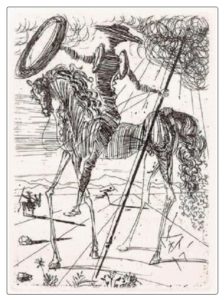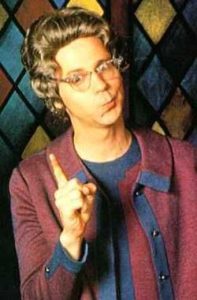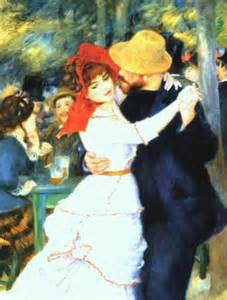The Marriage of True Minds
Around the time I turned twelve, I had an early and shocking coming-of-age moment of discovery. The whole family was at the drive-in to see “Geronimo” starring Chuck Connors, and no, the shock was not that white men, albeit, well-tanned ones, could play Indians in Hollywood movies. The recognition of that incongruity of casting would come later. The disturbance in the force was to learn that my father had drawn a line of distinction between his kids and his wife. “I love your mother more than I love you kids.” Imagine in my little mind the sound effect of screeching tires and the smell of burning rubber. The horror. The horror. The movie must not have been very good if Dad and I were having such a discussion.

I may have set myself up for this distress by foolishly and perhaps smugly asking Dad to merit his love between wife and children. I was shattered, my footing lost, my foundation crumbling. Dad tried to explain that it was a “different kind of love.” How could love be different? Love is love; one size fits all, no dissimilarities or categories to my twelve-year-old mind. I was distraught, but if Dad’s analogy was true, I could only take comfort in the fact that I was the first-born. Perhaps he loved me more than my siblings or at least he had loved me longer. I could not grasp how this “different kind of love” would be applied to any perspective wife I might meet in the future. “When you fall in love, son, then you will understand,” Dad explained.
In George Axelrod’s play “Will Success Spoil Rock Hunter?” (1955), a character explains, “Dear boy, the beginning of a movie is childishly simple. The boy and girl meet. The only important thing to remember is that—in a movie—the boy and the girl must meet in some cute way. They cannot…meet like normal people at, perhaps, a cocktail party or some other social function. No. It is terribly important that they meet cute.” A pretty stupid formula, however, romantic comedies have held to that standard for decades. The way Kay and I met was anything but cute. It was on a frozen pond playing broom hockey with a bunch of singles from church, and I knocked her on her butt going for the ball. Prior to that fortuitous moment, we had spied each other a few times “across a crowded room” (thank you Richard Rodgers), on different social occasions, but the broom hockey encounter stands out as “meet-uncouth” or “meet-boorish” or “meet-insufferable.” It was anything but Hollywood genteel.
I know it is hard to image me as insufferably boorish. Years later, Kay would write of that moment, “For heaven’s sake, it was an ice hockey game on a cold Sunday afternoon among friends on a Tennessee pond; it was not the playoffs for the National Hockey League. All participants were only mildly competitive, and not to win but to have fun. Chip came to win. I was not impressed with his intensity or lack of awareness of the socially obvious friendly rules of the game: polite competition, laughter, no injuries. From the moment Chip arrived on the scene, I certainly noticed him as he plowed through almost everyone on the ice including me. This was a perfect example of our different approaches to the world…bulldozer meets bashful babe.”

I, the bulldozer, accomplished two things that afternoon on the frozen pond: 1) her attention was captured, and 2) the current competition for her affection was put on notice. I quote one of my favorite characters in all fiction, “Love and war are all one. It is lawful to use sleights and stratagems to attain the wished end.” Don Quixote had it right. Kay was my “wished end,” and I would use any means necessary to win her over. When she accepted an offer for a first date, and then a second, and kept on accepting my requests for her company, I was smitten. I admit, I was the first to fall. From that early stage of love, I made the connection from Dad’s drive-in confession to loving Mom more than us kids, to my own falling in love with Kay. So this was what Dad was talking about…and unto me the light began to dawn and illumination filled my Cro-Magnon brain.
I know the experts can pooh pooh this idea of falling in love. I’ve heard sermons, listened to marriage specialists, read articles and books, seen the movies, etc., etc., pointing out the warning signs of the irrational attributes of falling in love and how it never lasts. I give these professionals their props, and would never contradict their warnings of the unrealistic expectations of the act of falling in love. When the bliss of the “fall” begins to melt away, without a principled and ethical foundation most of us panic and take flight leaving behind a bewildering morass of painful emotions. But in observing my parent’s forty-eight years of marriage, I saw up-close-and-personal their continual falling in love with each other. It was a perpetual courtship, a perpetual love affair, a perpetual choice where both insisted that romance was a vital component to daily life. That took work and commitment. That took overlooking each other’s human flaws and seeing each personality as a representation of God.
Kay and I could not be more different. The whole “opposites attract” dynamic was and is in full force with our marriage. I dance on tables and Kay sits at the table resetting the flower arrangement that I have knocked over. We realized long ago that forcing the other to conform into the other’s image of what a partner ought to be was doomed to fail. From bar stools to church pews, any place “two or three are gathered together,” Homo sapiens are in search of true love. The Culture has perpetuated the idea that one’s soul mate is just waiting to be discovered. However, a soul mate does not appear by conjuration or a “meet-cute.” A soul mate is made. As J.J.R. Tolkien said, “Nearly all marriages, even happy ones, are mistakes: in the sense that almost certainly (in a more perfect world, or even with a little more care in this very imperfect one) both partners might have found more suitable mates. But the real soul-mate is the one you are actually married to.”

There were a few who were skeptical about our pairing. One vocal Church Lady confronted Kay at church—thus the moniker—telling her she did not approve (I don’t recall us ever seeking her approval); that I was a big mistake (“He’s an actor,” stated to mean that my chosen profession and therefore my character were unreliable), that Kay would regret her decision, and the marriage was doomed to fail; false prophesies all around. The right people did approve: Kay’s family and mine, and, in the end, even the Church Lady received a wedding invitation, if only for her to witness our defiance.
The term used most often to describe the dissolution of a marriage is “irreconcilable differences.” When a couple reaches that point, the marriage is treated like a cadaver spread out on a cold, metal slab with mediators, judges, and lawyers carving up the remains. Kay and I have certainly faced our own troubles, decade’s worth, and our opposite personalities that were the source of the initial attraction have given cause for much grief. But those irreconcilable traits that have driven us crazy over the years have also proven to be keys to a more fulfilling marriage. Dad was right in word and deed when it came to falling in love with Mom, and I followed their example. I fell in love with Kay, I keep falling in love with her, and I’m committed to falling in love with her to infinity and beyond.
Kay’s fierce independence kept her skittish of my overt adoration for a little longer than I had hoped, but finally, my “wished end” walked down the aisle escorted by her two brothers, and we exchanged our vows on May 12th, Anno Domini, 1979. You do the math.

And so “to the edge of doom,” my love, I bear with you. William Shakespeare could not have versed it better:
“Let me not to the marriage of true minds
Admit impediments. Love is not love
Which alters when it alteration finds,
Or bends with the remover to remove.
O no! it is an ever-fixed mark
That looks on tempests and is never shaken;
It is the star to every wand’ring bark,
Whose worth’s unknown, although his height be taken.
Love’s not Time’s fool, though rosy lips and cheeks
Within his bending sickle’s compass come;
Love alters not with his brief hours and weeks,
But bears it out even to the edge of doom.
If this be error and upon me prov’d
I never writ, nor no man ever lov’d.
Sonnet 116


Cover Art: Dance at Bougival by Auguste Renoir; 1883

